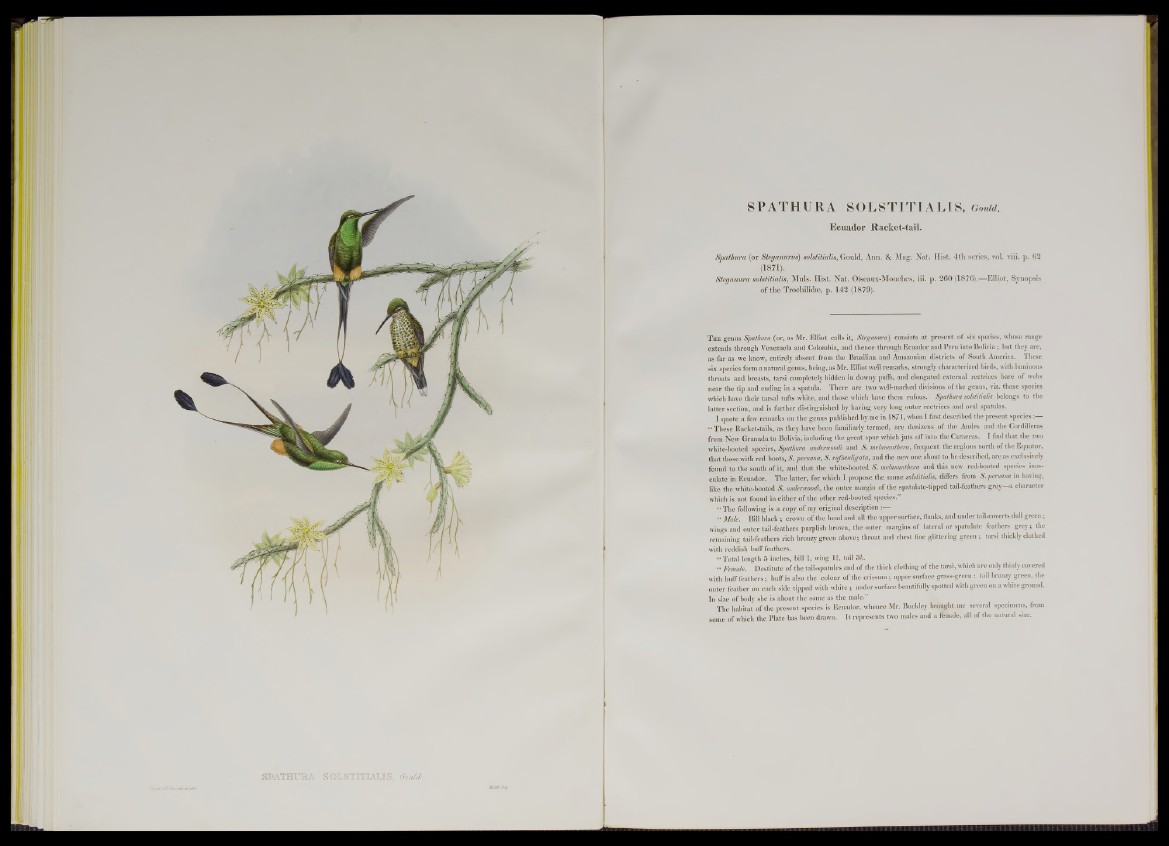
SPATHURA SOLSTITIALIS, â o iiU .
SPATHURA SOLSTITIALIS, Gouid.
Ecuador Racket-tail.
Spathura (or Steganurus) solstitialis, Gould, Ann. & Mag. Nat. Hist. 4 th sériés, vol. viii. p. 62
(1871).
Steganura solstitialis, Muls. H ist. N a t. Oiseaux-Mouches, iii. p. 2 6 0 (1876).— Elliot, Synopsis
o f th e Trochilidæ, p. 1 4 2 (1879).
T he genus Spathura (or, as Mr. Elliot calls it, Steganura) consists at present of six species, whose range
extends through Venezuela and Colombia, and thence through Ecuador and Peru into Bolivia ; but they are,
as far as we know, entirely absent from the Brazilian and Amazonian districts o f South America. These
six species form a natural genus, being, as Mr. Elliot well remarks, strongly characterized birds, with luminous
throats and breasts, tarsi completely hidden in downy puffs, and elongated external rectrices bare of webs
near the tip and ending in a spatula. There are two well-marked divisions of the genus, viz. those species
which have their tarsal tufts white, and those which have them rufous. Spathura solstitialis belongs to the
latter section, and is further distinguished by having very long outer rectrices and oval spatulas.
I quote a few remarks on the genus published by me in 1871, when I first described the present species :■—-
“ These Racket-tails, as they have been familiarly termed, are denizens o f the Andes and the Cordilleras
from New Granada to Bolivia, including the great spur which juts off into the Caraccas. I find that the two
white-booted species, Spathura underwoodi and S. melananthera, frequent the regions north of the Equator,
that those with red boots, S. peruana, S. rufocaligata, and the new one about to be described, are as exclusively
found to the south o f it, and that the white-booted S. melananthera and this new red-booted species inosculate
in Ecuador. The latter, for which I propose the name solstitialis, differs from S. peruana in having,
like the white-booted S. underwoodi, the outer margin of the spatulate-tipped tail-feathers grey a character
which is not found in either o f the other red-booted species.”
“ The following is a copy o f my original description :—
“ Male. Bill black ; crown o f the head and all the upper surface, flanks, and under tail-coverts dull green ;
wings and outer tail-feathers purplish brown, the outer margins of lateral or spatulate feathers grey; the
remaining tail-feathers rich bronzy green above; throat and chest fine glittering green ; tarsi thickly clothed
with reddish buff feathers.
“ Total length 5 inches, bill t , wing If, tail 3£.
“ Female. Destitute o f the tail-spatules and o f the thick clothing o f the tarsi, which are only thinly covered
with buff feathers; buff is also the colour o f the crissum; upper surface grass-green : tail bronzy green, the
outer feather on each side tipped with white ; under surface beautifully spotted with green on a white ground.
In size o f body she is about the same as the male.
The habitat o f the preseut species is Ecuador, whence Mr. Buckley brought me several specimens, from
some of which the Plate has been drawn. It represents two males and a female, all of the natural size.